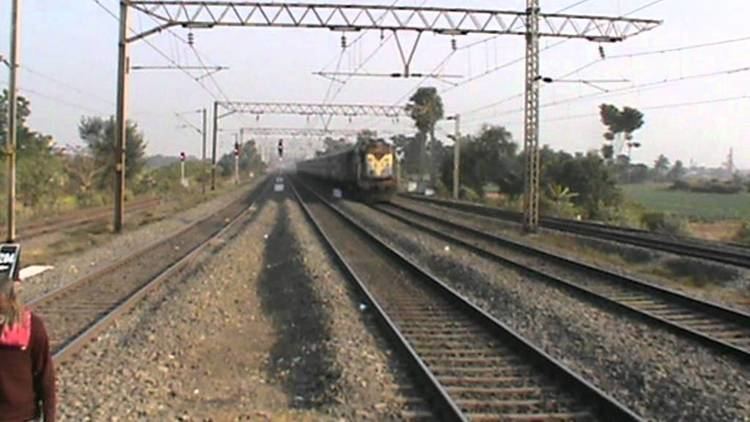Status Operational Line length 410 km (255 mi) Owner Indian Railways | Opened 1866 Number of tracks 1/ 2 Operator Eastern Railway zone | |
 | ||
Track gauge 1,676 mm (5 ft 6 in) broad gauge Terminis Kiul Junction railway station, Khana railway station Locale West Bengal, Jharkhand, Bihar | ||
The Sahibganj Loop is a railway line connecting Khana Junction and Kiul Junction. Originally a part of the Howrah-Delhi main line, it was opened to traffic in 1866. With the construction of a shorter railway line for a part of the route, the 410 kilometres (250 mi) stretch was assigned a separate identity.
Contents
- Kanchanjungha express enters the sahibganj loop enroute guwahati
- History
- Branch lines
- Developments
- Jamalpur Workshop
- Electrification
- References
Kanchanjungha express enters the sahibganj loop enroute guwahati
History
Railway transportation was introduced in India within 30 years of its maiden run in England.
The East Indian Railway Company which was formed on 1 June 1845, completed its survey for a railway line from Kolkata, then called Calcutta, to Delhi via Mirzapur in 1846. The company initially became defunct on refusal of government guarantee, which was given in 1849. Thereafter, an agreement was signed between East Indian Railway Company and the East India Company, for the construction and operation of an "experimental" line between Kolkata and Rajmahal, which would later be extended to Delhi via Mirzapur. Construction began in 1851.
On 15 August 1854, the first passenger train in the eastern section was operated up to Hooghly, 39 kilometres (24 mi) away. On 1 February 1855 the first train ran from Hooghly to Raniganj, 195 kilometres (121 mi) from Howrah. The priority accorded to the Raniganj section was because of the assurance of coal transportation.
The Khana Junction-Rajmahal section was complete in October 1859, crossing Ajay River on the way. The first train ran from Howrah to Rajmahal via Khana on 4 July 1860. The Loop from Khana Junction to Kiul via Jamalpur, including the Monghyr branch, was ready in February 1862.
From Rajmahal, construction progressed rapidly, moving westward along the banks of the Ganges, reaching Bhagalpur in 1861, Munger in February 1862, and opposite Varanasi (across the Ganges) in December 1862 and then on to Naini on the bank of the Yamuna. The work included EIR's first tunnel at Jamalpur and first major bridge across the Son River at Arrah.
During 1863-64, work progressed rapidly on the Allahabad-Kanpur-Tundla and Aligarh-Ghaziabad sections. The Yamuna bridge near Delhi was completed in 1864 and EIR established the Delhi terminus. The Yamuna bridge at Allahabad opened on 15 August 1865 and in 1866 Kolkata and Delhi were directly linked. The 1 Dn/ 2 Up Mail started running.
With the completion of the 406-kilometre (252 mi) long line connecting Raniganj with Kiul in 1871, a "shorter main line" was in position. Initially, it was called the chord line. However, as it attracted more traffic it was designated the main line and the original line became the Sahibganj loop.
Branch lines
In 1863, the Indian Branch Railway Company, a private company opened the Nalhati–Azimganj branch line. The 27 kilometres (17 mi) track was initially a 4' gauge line. The track was subsequently converted to 5' 6" broad gauge. The Indian Branch Railway Company was purchased by the Government of India in 1872 and the line was renamed Nalhati State Railway. It became a part of the East Indian Railway Company in 1892.
In 1913, the Hooghly–Katwa Railway constructed a line from Bandel to Katwa, and the Barharwa–Azimganj–Katwa railway constructed the Barharwa–Azimganj–Katwa loop line.
The Andal-Sainthia Branch Line was built in 1913.
The 53 kilometres (33 mi) long Ahmedpur Katwa Light Railway connecting Ahmedpur and Katwa, built on 760 millimetres (30 in), was opened to traffic on 29 September 1917.
Developments
Large portions of the Sahibganj Loop are still having single track. Twenty-one pairs of trains ply on the single track between Bhagalpur and Sahibganj. Work for doubling the 111-kilometre long (69 mi) stretch started in 2010.
Work on the new 130-kilometre (81 mi) long Rampurhat-Dumka-Mander Hill broad gauge line is progressing.
Jamalpur Workshop
Jamalpur Workshop, the first full-fledged railway workshop facility in India, was opened on 8 February 1862, at a time when the Howrah-Delhi main line, passing through Jamalpur was under construction. It was felt that communities of gun smiths and other craftsmen in the area handling mechanical engineering jobs could pick up the skills required in a railway workshop. It undertook repairs of wagons, coaches, cranes and tower cars, and locomotives, as well as manufacture of some tower cars, break-down cranes and various kinds of heavy-duty lifting jacks. They also produced their own locomotives, starting with the CA 764 Lady Curzon in 1899. It has also produced ticket printers and other ticket machines (slitting, counting, and chopping). With fairly extensive workshop facilities, it was a fairly self-contained.
Electrification
Electrification of the Khana-Sainthia-Pakur section was announced in the rail budget for 2010-11. The electrification of Ahmedpur-Sainthia-Murarai section is expected to be completed during the last months of 2013.The first electric train service is started from 29th September 2016 through HWH-RPH express. Also the electrification of Bonidanga Link Cabin-Barharwa-Sahibganj-Kiul section Including the Tinpahar-Rajmahal section (Announced by PM Modi in Bihar Package) is expected to start after the completion of Pirpainti-Bhagalpur section doubling.
